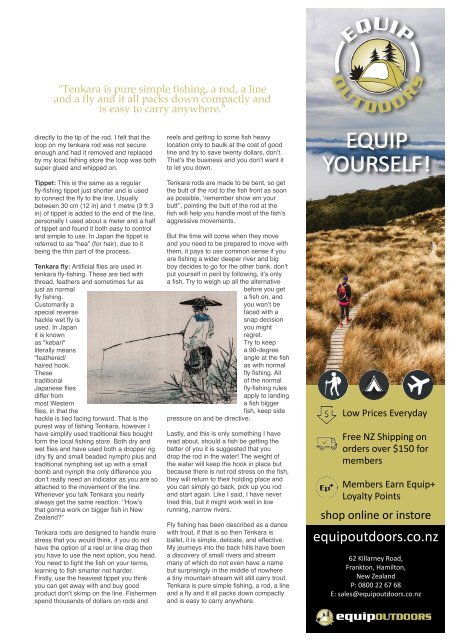You also want an ePaper? Increase the reach of your titles
YUMPU automatically turns print PDFs into web optimized ePapers that Google loves.
"Tenkara is pure simple fishing, a rod, a line<br />
and a fly and it all packs down compactly and<br />
is easy to carry anywhere."<br />
directly to the tip of the rod. I felt that the<br />
loop on my tenkara rod was not secure<br />
enough and had it removed and replaced<br />
by my local fishing store the loop was both<br />
super glued and whipped on.<br />
Tippet: This is the same as a regular<br />
fly-fishing tippet just shorter and is used<br />
to connect the fly to the line. Usually<br />
between 30 cm (12 in) and 1 metre (3 ft 3<br />
in) of tippet is added to the end of the line,<br />
personally I used about a meter and a half<br />
of tippet and found it both easy to control<br />
and simple to use. In Japan the tippet is<br />
referred to as "hea" (for hair), due to it<br />
being the thin part of the process.<br />
Tenkara fly: Artificial flies are used in<br />
tenkara fly-fishing. These are tied with<br />
thread, feathers and sometimes fur as<br />
just as normal<br />
fly fishing.<br />
Customarily a<br />
special reverse<br />
hackle wet fly is<br />
used. In Japan<br />
it is known<br />
as "kebari"<br />
literally means<br />
“feathered/<br />
haired hook.<br />
These<br />
traditional<br />
Japanese flies<br />
differ from<br />
most Western<br />
flies, in that the<br />
hackle is tied facing forward. That is the<br />
purest way of fishing Tenkara, however I<br />
have simplify used traditional flies bought<br />
form the local fishing store. Both dry and<br />
wet flies and have used both a dropper rig<br />
(dry fly and small beaded nymph) plus and<br />
traditional nymphing set up with a small<br />
bomb and nymph the only difference you<br />
don’t really need an indicator as you are so<br />
attached to the movement of the line.<br />
Whenever you talk Tenkara you nearly<br />
always get the same reaction. ‘’How’s<br />
that gonna work on bigger fish in New<br />
Zealand?”<br />
Tenkara rods are designed to handle more<br />
stress that you would think, if you do not<br />
have the option of a reel or line drag then<br />
you have to use the next option, you head.<br />
You need to fight the fish on your terms,<br />
learning to fish smarter not harder.<br />
Firstly, use the heaviest tippet you think<br />
you can get away with and buy good<br />
product don’t skimp on the line. Fishermen<br />
spend thousands of dollars on rods and<br />
reels and getting to some fish heavy<br />
location only to baulk at the cost of good<br />
line and try to save twenty dollars, don’t.<br />
That’s the business and you don’t want it<br />
to let you down.<br />
Tenkara rods are made to be bent, so get<br />
the butt of the rod to the fish front as soon<br />
as possible, ‘remember show em your<br />
butt’’, pointing the butt of the rod at the<br />
fish will help you handle most of the fish’s<br />
aggressive movements.<br />
But the time will come when they move<br />
and you need to be prepared to move with<br />
them, it pays to use common sense if you<br />
are fishing a wider deeper river and big<br />
boy decides to go for the other bank, don’t<br />
put yourself in peril by following, it’s only<br />
a fish. Try to weigh up all the alternative<br />
before you get<br />
a fish on, and<br />
you won’t be<br />
faced with a<br />
snap decision<br />
you might<br />
regret.<br />
Try to keep<br />
a 90-degree<br />
angle at the fish<br />
as with normal<br />
fly fishing. All<br />
of the normal<br />
fly-fishing rules<br />
apply to landing<br />
a fish bigger<br />
fish, keep side<br />
pressure on and be directive.<br />
Lastly, and this is only something I have<br />
read about, should a fish be getting the<br />
better of you it is suggested that you<br />
drop the rod in the water! The weight of<br />
the water will keep the hook in place but<br />
because there is not rod stress on the fish,<br />
they will return to their holding place and<br />
you can simply go back, pick up you rod<br />
and start again. Like I said, I have never<br />
tried this, but it might work well in low<br />
running, narrow rivers.<br />
Fly fishing has been described as a dance<br />
with trout, if that is so then Tenkara is<br />
ballet, it is simple, delicate, and effective.<br />
My journeys into the back hills have been<br />
a discovery of small rivers and stream<br />
many of which do not even have a name<br />
but surprisingly in the middle of nowhere<br />
a tiny mountain stream will still carry trout.<br />
Tenkara is pure simple fishing, a rod, a line<br />
and a fly and it all packs down compactly<br />
and is easy to carry anywhere.<br />
equip<br />
yourself!<br />
Low Prices Everyday<br />
Free NZ Shipping on<br />
orders over $150 for<br />
members<br />
Members Earn Equip+<br />
Loyalty Points<br />
shop online or instore<br />
equipoutdoors.co.nz<br />
62 Killarney Road,<br />
Frankton, Hamilton,<br />
New Zealand<br />
P: 0800 22 67 68<br />
E: sales@equipoutdoors.co.nz
















